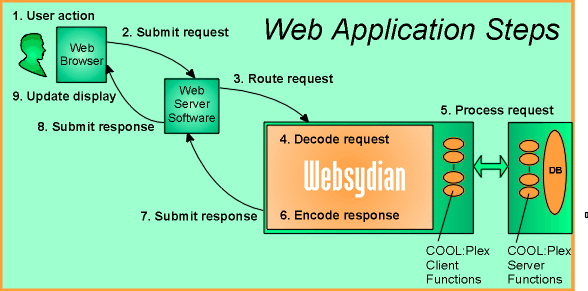|
|
Users Guide | Patterns Reference | WebsydianExpress | Search |
|
|
Users Guide | Patterns Reference | WebsydianExpress | Search |
Websydian shields Advantage Plex developers from most of the complexities involved in developing applications for the Web. This frees developers to concentrate on what for them are most important:
The Business Logic of the application.
Almost all of the chores involved in Web application development are handled automatically by Websydian.
However, to really appreciate the Value of Websydian, let's take a look at what is really required to develop applications for the Web:
Web Applications invariably have two halves: The client side and the server side. Between the two travel Web requests in one direction and Web responses (Web Pages encoded in HTML) in the other.
Developing a Web application requires the construction of Web pages and corresponding program logic to ensure the right flow of Web requests and responses.
Under normal circumstances, this means that the developers must manually ensure that each possible action is handled correctly by some corresponding program logic, and - conversely - that each piece of program logic receives the input from the Web browser it expects.
The many dependencies from Web page to program logic, and back again basically tend to make Web development a huge puzzle. Even small changes tend to ripple through lots of program logic and Web pages, each taking an inordinate amount of time to complete.
Websydian, on the other hand, takes advantage of the unique capabilities of Advantage Plex, which permits a global view of the Web Application, allowing most of the puzzle-like dependencies to be resolved automatically.
Websydian generates both the program logic and the corresponding Web pages, always ensuring correct correspondence between the two. The value of this feature alone is hard to exaggerate.
The steps from a user request to a Websydian application to the display of the response in a Web browser is depicted in the figure below.

The steps are the following:
To build a Web Application without Websydian, you must design, implement, and test steps 4 through 7 (colored red in the above list).
However, being a Websydian user, you get steps 4, 6, and 7 for free. So:
You only have to do step 5!
And step 5 cannot be built into a standard component, because it is inherently application dependent. Only the application developer can know what processing is required to produce an appropriate response to a given request.